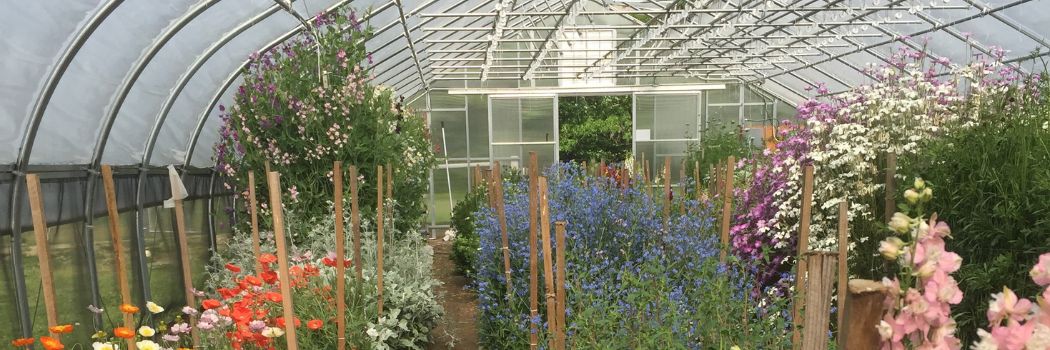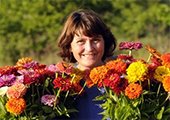- 3 Easy, Reliable, Productive Cut Flowers: Sunflowers, Zinnias & Rudbeckia
- 5 Factors That Determine Vase Life of Cut Flowers
- 2019 American Flowers Week: Combining the Art of Floral Design & Couture
- Celebrate the 7th American Flowers Week | Johnny's 2021 Botanical Couture
- Celebrating the 8th American Flowers Week | Johnny's 2022 Botanical Couture
- Collective Selling Models for Flower Farmers: Flower Hubs That Work
- 5 Cool Flowers to Plant Now | Lisa Mason Ziegler's Secrets for Growing Hardy, Cool-Season Annuals
- Cut-Flower Harvesting & Post-Harvest Care | Best Practices from Pros in the Slow Flower Community
- Cut-Flower Kit | Guide for Market Growers (PDF)
- Easy Cut-Flower Garden Map | For Growers New to Flowers (PDF)
- Easy Cut-Flower Garden Planner | For Growers New to Flowers (PDF)
- From Color to Climate: 5 Floricultural Trends Subtle & Seismic
- Flower Culture by Crop | Comparison Chart | Days to Germination, Weeks to Transplant, Days to Harvest (PDF)
- Flower Farmers' Favorite Fillers & Foliage | Recommendations from 3 Farmer-Florists
- Getting Started in Cut-Flowers | Top 15 Cuts
- Heat & Drought: How Flower Farmers Are Adapting to Changing & Challenging Climatic Conditions
- Introduction to Overwintering Flowers | Guide to Overwintering Flowers
- An Introduction to Producer Marketing Cooperatives | M Lund & Associates
- How Day Length Affects Cut-Flower Production
- Growing Flowers in Hoophouses & High Tunnels: Cool-Weather & Hot-Weather Options
- Starting a U-Pick Flower Farm, From A-to-Z
- Roadside Flower Stand Basics: Success Tips for On-Farm Retail
- Year-Round Flower Production Strategy
- Overwinter Flower Trials | Multiyear Results for 30+ Crops | Johnny's Selected Seeds | XLSX
- Seeding Date Calculator | Johnny's Recommended Flowers for Overwintering | XLSX
- Just Add Flowers | An Introduction to Companion Planting for Vegetable & Herb Gardeners
- Pricing & Profitability for Flower-Farmers | Pointers from a Diversity of Pros
- Sustainable Farming Methods | A Survey of Flower Farmers' Best Practices
- Slow Flowers Palette & Petal Crushes | Evolving Colors & Shape-Shifts in Floral Industry Trends
- Johnny's and Slow Flowers | Johnny's Selected Seeds
- Slow Flowers | Celebrating Fifth-Season Regional Design Elements
- Slow Flowers Floral Forecast | A Summary of Industry Insights & Trends
- Building a Better Market Bouquet: Tips, Techniques & Recipes for Flower Farmers
- Slow Flowers | Tips for Staging On-Farm Floral Workshops | Johnny's Selected Seeds
- Wedding Wisdom 101 | 10 Beginner Tips for Entering the Wedding Floral Landscape
- Succession-Planting Flowers | Scheduling & Planning, Sowing Frequency, Recordkeeping & Recommendations
- Succession-Planting Interval Chart for Flowers
- Sustainable Floral Design | Techniques & Mechanics for Foam-Free Floristry | Tobey Nelson & Debra Prinzing
- Video: Mason Jar Bouquet Tutorial
- Video: How to Build a Bouquet
- Video: Tobey Nelson | Sustainable Floral Design | Slow Flowers Summit
- Video: Economic Considerations in Overwintering Cut Flowers | Johnny's Selected Seeds
- Top 10 Cut-Flower Varieties for Direct Seeding
- Video: Floating Row Cover | Baby "Cool Flower" Protection from Whipping Winter Winds
- Video: The Procona System for All-in-one Flower Harvest, Transport & Display
- Johnny's Overwinter Flowers Tunnel: Trellising, Supports, Ground Cover & Spacing
- Video: Irrigation Considerations for the Overwinter Flowers Tunnel | Johnny's Selected Seeds
- Video: Johnny's Overwinter Flowers Trial Recap
- Video: Producer Cooperatives for Small-Scale Farmers | Johnny's Webinar Series
- Climate Adaptation for Vegetable & Flower Farmers | Johnny's Educational Webinar Resources
- Chrysal Classic Professional 2 Transport & Display (Holding) Solution | SDS
- Choosing Flower Crops to Overwinter | Guide to Overwintering Flowers
- Chrysal Clear Universal Flower Conditioner | SDS
- U-Pick Power for Your Flower Farm | Johnny's Webinar Series
- Chrysal Professional 3 Vase Solution Powder | SDS
- Bloom to Boom: Flower Farm Profitability
- Webinar Slide Deck | U-Pick Power for Your Flower Farm | PDF
- Chrysal Professional 1 Hydration Solution | SDS
- Edible Flowers List: Top 20 Favorites from the Slow Flowers Community
- U-Pick Power for Your Flower Farm | Johnny's Webinar Series
- Floral Standards for Flower Farm Collectives and Cooperatives
- Chrysal Professional 2 Transport & Display T-Bag | SDS
- Eat Your Flowers: Serve Up That Wow Factor With Edible Flowers
- Chrysal CVBN Flower Conditioner | SDS
- When to Start Seeds for Overwintered Flowers | Guide to Overwintering Flowers
- Introduction to Forcing Flower Bulbs in Soil | Guide to Forcing Flower Bulbs
- Webinar Slide Deck | Flower Growing in Southern States | PDF
- Forcing Tulip Bulbs | Guide to Forcing Flower Bulbs
- 10 Tips for Building a Profitable Cut-Flower Business
- Chrysal Clear Bulb T-Bag | Cut-Flower Conditioner | SDS
- Video: Flower Growing in Southern States | Johnny's Webinar Series
- Flower Growing in Southern States | Johnny's Educational Webinar Series
- Chrysal Clear Bulb Flower Conditioner | SDS
- Choosing Tulip Varieties for Forcing | Guide to Forcing Flower Bulbs
- Snapdragon Groups Explained
- Flowering in the South: Profiles of 5 flower farmers who cope with temperature, humidity, pest & weed pressure
- Webinar Slide Deck | New-for-2023 Flowers & Floral Supplies | PDF
by Lynn Byczynski, Author & Founder of Growing for Market
Flowers are a natural addition to a market farm or vegetable garden, and a beautiful way to increase revenue and extend the season. They have the same cultural requirements as vegetables, for the most part. Start them in the greenhouse as you would a vegetable or herb crop you intend to transplant. Outside, grow them in the same beds, rotating with other crops, with much the same tools, fertility, and irrigation.
Flowers attract bees and other pollinators that help increase yields and quality of your other crops. And watch for the many beneficial insects that will hover around your flowers until they find some vegetable pests to prey on. Flowers attract people, too, with their colors and fragrances. They will beckon customers to a farmers' market stand and add value to a CSA share. Johnny's offers a wide selection of flowers that are easy to grow from seed, providing you with the best possible profits. And there's something for every season.
Spring
In spring, offer a selection of bedding plants ranging from always-popular petunias to less common varieties such as Gem marigolds, phlox, and the more diminutive zinnias. Create your own themed collections of plants and group them with colorful signs to explain the connection. Be imaginative and educational: Grandmother's Garden for heirlooms such as hollyhocks and sweet peas; Butterfly Rest Stop for plants that migrating Monarchs feed on such as asclepias, tithonia, and zinnia; Glorious Garnish for edibles such as calendula and viola. And don't forget the customers who don't have time or space to plant their own pots. Create instant gardens for patios and decks, mixing flowers, herbs and even vegetables in big containers.
To learn more, see our article on Succession Planting Flowers.
Summer
In summer, sell cut flowers at farmers markets and farm stands, to supermarkets and florists. Many CSA farms offer bouquet shares or have a few beds of flowers for members to cut themselves on pick-up day. If you're just starting with flowers, try a few basic crops such as sunflowers and zinnias, which can be planted with a push seeder and require little attention other than weeding and watering until its time to harvest them. Grow some easy fillers such as cinnamon basil, statice, and celosia; the result will be dramatic summer bouquets!
To learn more, see our article on Building a Better Market Bouquet.
Fall
Fall brings an opportunity to sell florals along with pumpkins and gourds. Sunflowers, grasses and grains have an autumnal look that sells well beginning in September. Wreaths made of broom corn, sweet Annie, or ornamental peppers are easy to make and can be sold right away or weeks later after they have dried. Arrangements of dried flowers are coming back into style for fall decor, and are perceived as being a good value because they'll last for months.
To learn more, see our tutorial on Drying Flowers.
Winter
You also can extend the fresh flower season by planting in a hoophouse in late summer. For example, by September 1, you can plant a final crop of a day-neutral sunflower such as 'Sunbright Supreme', to bloom in late October through Thanksgiving. Fall-plant flowers that need a cold period, such as sweet William and larkspur, to bloom early next spring.
To learn more, see our comprehensive resources page for Overwintering Flowers • How to Extend Your Season with Cold-Hardy Annuals.
Byczynski and her family have been growing vegetables and cut flowers since 1988, selling through CSAs, at farmers' markets, to chefs, grocery stores, and florists. They currently grow cut flowers and hoophouse tomatoes on about 2 acres of their 20-acre farm near Lawrence, Kansas.
She is also the author/editor of two of our favorite books about market farming, The Flower Farmer and The Hoophouse Handbook.



